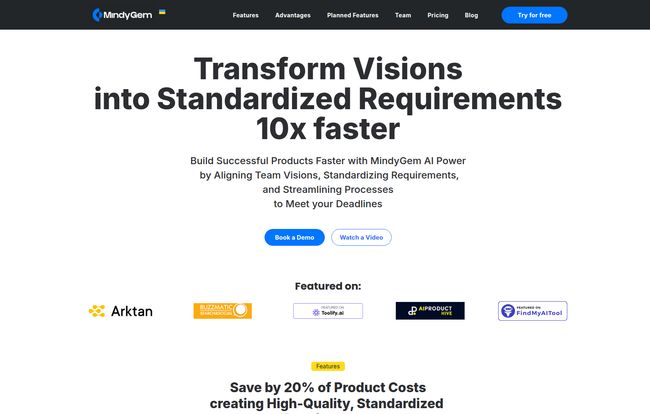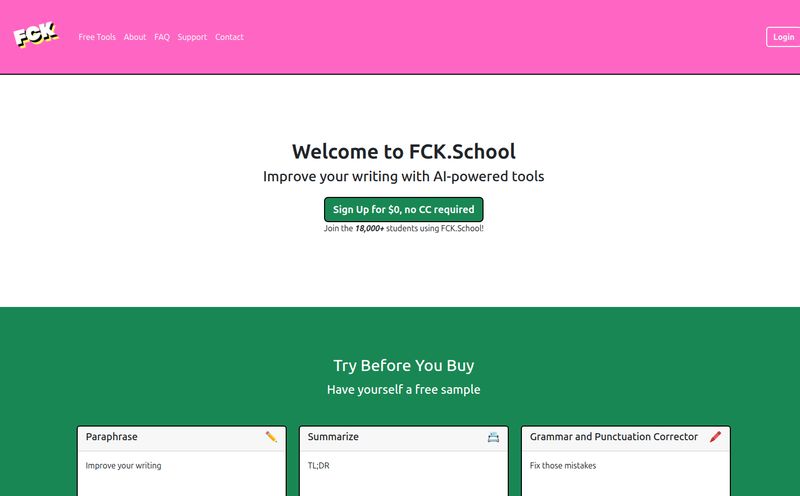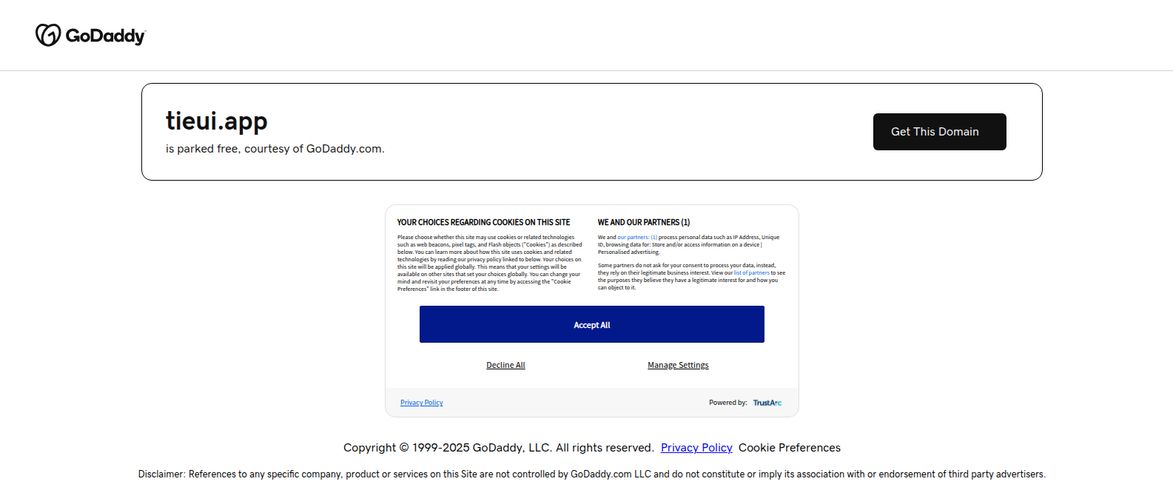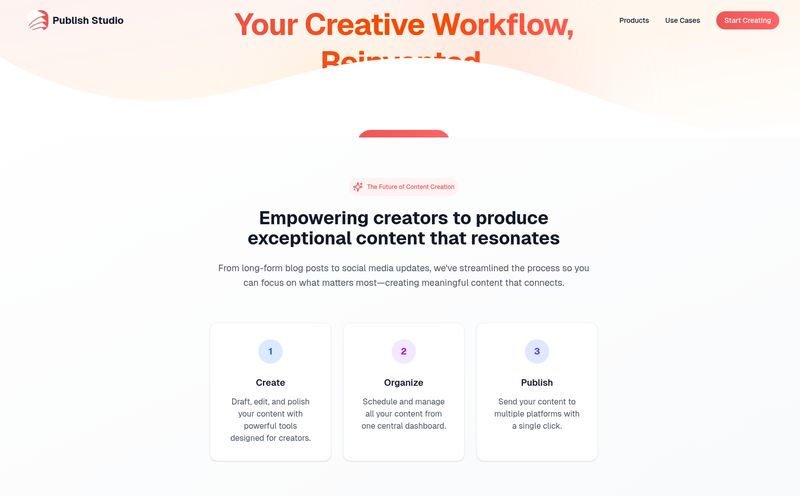We've all been there. That Monday morning meeting where the product manager, lead designer, and senior dev are all describing three completely different versions of the same feature. It's the product development version of the telephone game, where a brilliant idea whispered at the start becomes a garbled mess by the time it reaches the keyboard.
I’ve spent years neck-deep in the trenches of traffic generation and product launches, and if there’s one thing that consistently sinks timelines and inflates budgets, it’s miscommunication. A vague requirement, a missed dependency, an edge case nobody thought of until three days before launch... sound familiar? It’s the stuff of nightmares. Or, you know, just a regular Tuesday in tech.
So when a tool like MindyGem lands on my radar, promising to use AI to “transform visions into standardized requirements” and save up to 20% on product costs, my professional skepticism kicks in. But so does my curiosity. A 20% saving is a massive claim. Is this just another piece of vaporware, or could it be the translator we’ve all been waiting for? I had to take a look.
So, What is MindyGem, Really?
At its core, MindyGem isn't trying to be another all-in-one project management beast like Jira or Asana. Thank goodness. Instead, it’s a specialized AI-powered requirements management software. Its entire purpose is to live in that messy, chaotic space between the initial “what if?” and the final, actionable developer ticket.
It’s designed to take your high-level ideas, your feature concepts, even your UI/UX designs, and use artificial intelligence to break them down into the nitty-gritty details. We're talking about generating full-blown product requirement documents (PRDs), decomposing epics into neat user stories with acceptance criteria, and even creating technical specs. The goal is to create a single, clear source of truth that everyone on the team—from marketing to management to engineering—can actually understand and agree on. A lofty goal, but a worthy one.
The Core Features That Actually Matter
I’ve seen a lot of SaaS homepages throw feature lists at the wall to see what sticks. MindyGem’s is pretty focused, which I appreciate. They seem to be targeting some very specific, very real pain points in the product lifecycle.
AI That Writes Your Homework (The Docs)
The first thing that jumps out is the AI-powered document generation. The idea is you answer a few strategic questions about your product, and MindyGem’s AI spits out a comprehensive document. If this works as advertised, it could be a godsend for product managers who spend half their lives just writing and re-writing specs. It’s like having a junior PM on staff who never needs a coffee break.
From Pretty Pictures to Hardcore Tech Specs
This one really caught my eye. MindyGem claims to generate technical requirements directly from UI/UX designs. This is the bridge over a notoriously troubled water. How many times has a beautiful Figma design been handed to a developer, only for them to say, “Yeah, but what’s the API endpoint for this button?” By connecting the visual to the technical, you’re not just saving time; you’re preventing a whole category of frustration and rework. It's a huge step towards making design and development speak teh same language.

Visit MindyGem
Slicing and Dicing Epics Without a Meltdown
Breaking down a giant feature (an “epic”) into smaller, manageable user stories is an art form. It’s also tedious. MindyGem automates this, turning your big idea into smaller stories, complete with suggestions for acceptance criteria. This doesn't just speed things up; it enforces consistency. No more one-line user stories with zero detail. Hallelujah.
This all feeds into their bigger idea of “Streamlined Collaboration” through a unified knowledge base. It's an attempt to kill the chaos of requirements living in a dozen different Google Docs, Slack threads, and Confluence pages that haven't been updated since last year.
But Does It Actually Help? A Word from the Wise
Features are nice, but results are what pay the bills. The site highlights benefits like reducing time, improving product quality, and simplifying work processes. These are the holy grails of product development. The testimonial from Salman K. at Reasles adds a bit of weight to it all:
"The AI capabilities of MindyGem are so impressive, it helped us spot dependencies and edge cases we'd never thought of."
This quote is more telling than a list of features. Spotting dependencies and edge cases early is where the real money is saved. That’s how you avoid the dreaded “oh, crap” moment a week before launch. That’s how you get to that 20% cost-saving figure they’re so proud of.
Let's Talk Money: MindyGem Pricing
Alright, so I was all geared up to check out the official pricing page and… whoops. A wild 404 error appeared. It happens to the best of us, especially with newer platforms. A bit of a slip-up, but it's not a dealbreaker. Fortunately, I was able to piece together the pricing structure.
Here’s what you can expect to pay for MindyGem, presented in a handy table:
| Plan | Price per Member/Month | Key Features |
|---|---|---|
| Basic | $19 | Basic templates, user stories & epics, up to 3 viewers, 1 GB storage, 500 AI tokens. |
| Standard | $29 | All Basic features, plus up to 15 tech design specs, PDF export, Jira Integration, 10 viewers, 2 GB storage, 1000 AI tokens. |
| Premium | $99 | All Standard features, plus unlimited tech specs, custom docs, unlimited storage & AI tokens, premium support. |
My take? The Basic plan feels like a good entry point for a small team or a single product manager wanting to test the waters. The real value seems to kick in with the Standard plan. That Jira integration is the key—it’s what makes this a practical tool that fits into an existing workflow rather than a siloed new toy. The Premium plan is clearly for larger organizations or power users who are all-in on the AI-driven approach and need unlimited everything.
The Not-So-Shiny Parts: A Reality Check
No tool is perfect, especially not a new one. A good review needs to look at the potential downsides, and MindyGem has a few things to keep in mind.
The "Coming Soon" Conundrum
The homepage openly lists several “Planned Features,” like reading tickets from other platforms and running test cases. This is both exciting and a little worrying. It’s great that they have a vision for growth, but you have to evaluate the tool based on what it does today, not what it might do next year. It's a classic SaaS balancing act for customers.
The AI is a Copilot, Not the Pilot
As impressive as the AI might be, it’s not magic. It's a predictive engine based on patterns. It will still require a sharp human mind to review its output, catch subtle business logic it might miss, and provide the final sign-off. Thinking you can just fire your product team and replace them with MindyGem is a recipe for disaster. Think of it as an incredibly powerful assistant that frees up your experts to do more strategic work.
Integration is Everything
The tool’s power is magnified by its ability to connect with your other tools. Right now, the big one is Jira. Their roadmap suggests more are coming. But if your team lives and breathes in a different ecosystem (say, ClickUp or Azure DevOps), you might find its utility a bit limited until those integrations are built out.
Who Should Use MindyGem (And Who Can Skip It)?
After digging in, I have a pretty clear idea of who would get the most out of MindyGem.
This is a fantastic tool for:
- Product Managers and Product Owners who are buried in documentation and clarification meetings.
- Agile Startups and Scale-ups looking to build a standardized, repeatable process for product development without hiring a huge team.
- Teams with communication gaps between design, product, and engineering.
- Companies that want to launch features faster and with fewer bug-fixing sprints caused by vague requirements.
You might want to hold off if:
- You're a solo founder working on a very simple app. The overhead might not be worth it.
- Your team is tiny and communication happens organically over a single desk.
- You are deeply, irrevocably tied to a project management ecosystem that MindyGem doesn't currently support.
My Final Take on MindyGem
So, is MindyGem the silver bullet for all product development woes? Of course not. But it’s one of the most interesting and focused stabs at solving a very real, very expensive problem that I’ve seen in a while. It’s not just throwing AI at a problem for the sake of it; it’s applying it to a specific, high-friction area of the development process.
The promise of saving 20% on product costs isn't just marketing fluff; it's a direct outcome of what happens when you reduce ambiguity, avoid rework, and get everyone on the same page. MindyGem is an ambitious tool, and it feels like it's just getting started. If they can deliver on their planned features and keep refining the AI, it could easily become an indispensable part of the modern tech stack. For now, it’s a powerful contender and absolutely worth a look for any team tired of playing the product development telephone game.
Frequently Asked Questions
- 1. What exactly is MindyGem?
- MindyGem is an AI-powered software specifically for requirements management. It helps teams create detailed product documents, user stories, and technical specifications from high-level ideas and designs to streamline product development.
- 2. How does MindyGem claim to save 20% on product costs?
- The cost savings come from creating high-quality, standardized requirements upfront. This reduces ambiguity, minimizes rework, shortens timelines, and helps teams catch potential issues and edge cases early in the process, which is far cheaper than fixing them after development.
- 3. Is MindyGem suitable for small teams?
- Yes, the Basic plan at $19/month per member is designed for small teams or even individual product managers. It provides the core functionality to start organizing requirements more effectively.
- 4. Does MindyGem replace the need for a Product Manager?
- No, definitely not. It's a tool to augment and assist a Product Manager, not replace them. It automates tedious documentation tasks, allowing the PM to focus on higher-level strategy, user research, and team leadership. Human oversight is still critical.
- 5. What key integrations does MindyGem offer?
- Currently, the most significant integration is with Jira, which is available on the Standard plan and above. They have more integrations planned for the future to connect with other popular development tools.
References and Sources
- MindyGem Official Website
- MindyGem Pricing Page (Link was inactive at time of writing)
- Arktan (Platform where MindyGem was featured)



